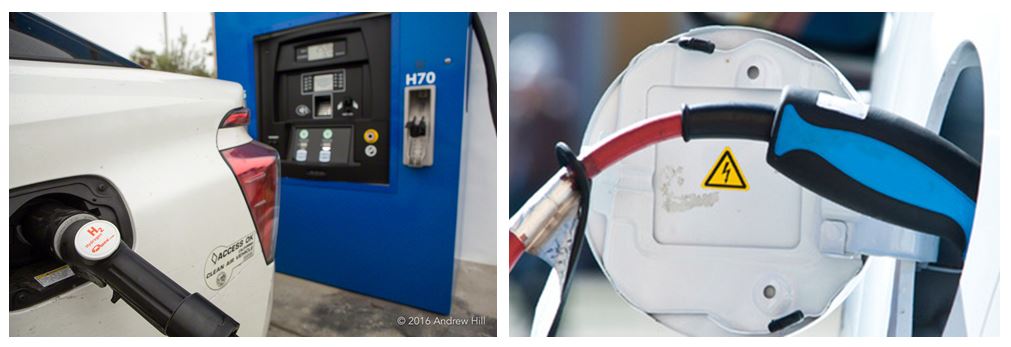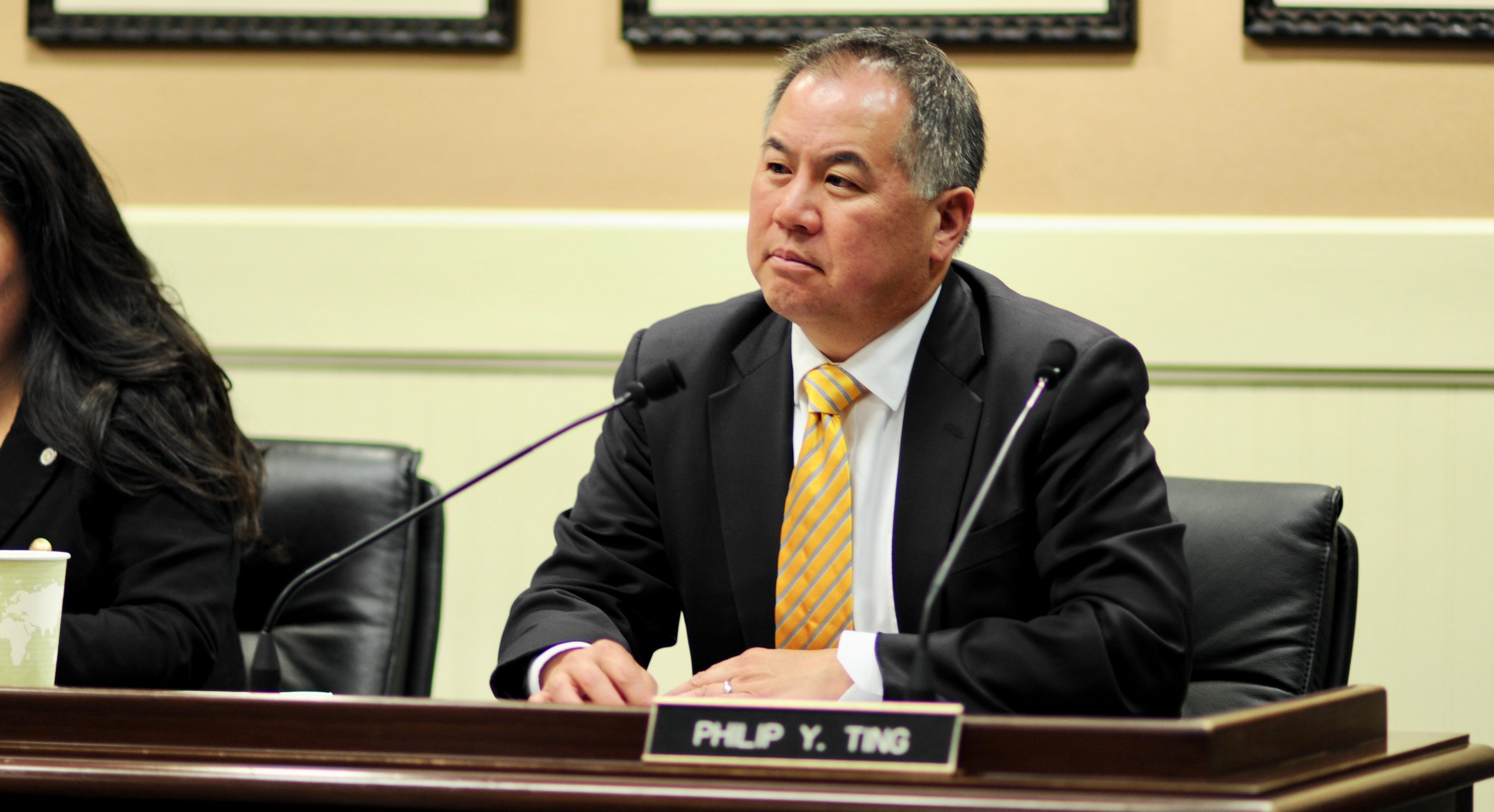
Electric vehicle charging. (Photo: cdn.businessportal.ca.gov
California Energy Commission Approves $1.4 Billion Zero-Emission Vehicle Infrastructure Plan
‘Suddenly having a ton of these charging and refueling stations across the state will outpace demand for the vehicles’
By Evan Symon, November 17, 2021 2:30 am
The California Energy Commission (CEC) approved a a three-year $1.4 billion zero-emission vehicle (ZEV) infrastructure plan on Monday, aiming to get the state to meet 2025 electric vehicle charging and hydrogen fueling goals.
Press play to hear a narrated version of this story, presented by AudioHopper.
According to the 2021-2023 Investment Plan Update for the Clean Transportation Program, the program will receive another $1.1 billion from the 2021-2022 state budget, improving it by about six times from it’s original planned budget of $238 million. While the expanded plan mostly focuses on ZEV infrastructure such as the construction of charging stations, hydrogen fueling centers, the manufacturing of needed ZEV infrastructure pieces and parts, and the purchase of thousands of zero-emission buses and trucks, other considerations around the buildout of zero-emission infrastructure will also be added, such as workforce training and development and ZEV fuel production.
In total, $690 million will go to medium-and heavy-duty ZEV infrastructure such as battery-electric and hydrogen), $314 million will go to light-duty electric vehicle charging infrastructure, $244 million will go to ZEV manufacturing, and $77 million will go to hydrogen refueling infrastructure. Smaller parts of the plan, including $15 million for workforce training and development, as well as $25 million for zero-and near-zero-carbon fuel production and supply, are also included.
According to the CEC, the funds will become available over the next two years and distributed to projects through both competitive funding and direct funding endeavors. In a statement on Monday, the CEC noted that the new funding plan will help California not only meet 2025 ZEV infrastructure goals and quicken public adoption of zero-emission vehicles, but would also support Governor Gavin Newsom’s Executive Order that will phase out all new sales of gas-powered vehicles in California by 2035.
“This plan charts the path for Governor Newsom’s historic budget investments in zero-emission transportation infrastructure and manufacturing,” said Lead Commissioner for Transportation Patty Monahan on Monday. “These dollars close the 2025 infrastructure funding gap so that access to charging and hydrogen fueling isn’t a barrier for those exploring cleaner transportation options including individuals, businesses and public agencies.”
A $1.4 Billion ZEV Infrastructure Plan
While the plan, which was created from input by clean energy transportation committees and state transportation and environmental agencies, fills the funding gap for the 2025 ZEV infrastructure goal, opponents say that the higher funding is not needed and that the infrastructure should go up as the demand goes up organically.
“California is preparing for a future with more electric and alternative fuel cars,” alternative energy advisor Ellen Thompson told the Globe on Tuesday. “But this isn’t the right way to prepare. Suddenly having a ton of these charging and refueling stations across the state will outpace demand for the vehicles. The system will be underused for years.”
“When gas-powered cars became a bigger and bigger thing in the early 20th century, gas station came up as the demand was needed. Companies like Standard Oil, which in California became Chevron after the breakup of the company, built as needed. When new highways were built, so also came gas stations. Same thing happened with inns and stables on old stagecoach and mail lines, or oil, coal, and sand stations on train lines.”
“California isn’t allowing companies to do this at their own pace, like Tesla has done with their charging stations, or how they have been built as something as a perk at office or commercial parking places. It’s good we’re thinking about it, but what we’ll end up with is way more charging stations than needed for years until electric car demand ticks more upwards. And it’s the taxpayers who will be eating the loss on this.”
Other clean energy transportation plans, such as a $1.5 billion California Air Resources Board (CARB) plan for ZEV rebates and equipment investments, are up for public meetings and votes in the coming weeks.
- Man Who Broke Into L.A. Mayor’s Home to Receive Probation, Mandatory Drug Treatment - July 25, 2024
- California National Guard Counterdrug Task Force Seizes nearly $4 Million Worth Of Fentanyl In June Following Ramping Up Of Actions - July 24, 2024
- San Francisco’s Guaranteed Income Programs for Trans People to End - July 24, 2024





They built some of these charging stations in a Target and Walgreen’s parking lot in our city. Whenever I have gone shopping there, those stations have been empty (not used). And assuming that a few people do drive EVs, what does that tell you?
The spin in this AAA survey is that ownership cures concerns about EVs; such as charging time and distance per charge. Clearly, people who own them are only using them for commuting short distance trips around town and charging them at home (using our overburdened power grid). What they don’t consider is the cost of ownership over a long period; aside from routine maintenance; taking into account initial cost and replacement parts. How often will you need a new engine? They are now making crate electric engines which cost upwards of $4000 (not including installation cost); not to mention the batteries and computer. So, how many replacements would an EV need during one lifetime; say 250k miles? No one knows for sure yet, because they haven’t been driven that long. The price of EVs would have to be a LOT less before I’d even think about owning one – maybe half the price now days.
https://newsroom.aaa.com/2020/01/aaa-owning-an-electric-vehicle-is-the-cure-for-most-consumer-concerns/
And no one talks about DISPOSAL of batteries. Where? How? An environmental nightmare.
Recycling batteries is being studied; but with lots of hurdles to overcome: https://startup-energy.org/wp-content/uploads/Brochure_Battery_Recycling_2021-gb.pdf
What it tells us is that BEV market share growth was slow and primarily followed other new technologies in that early adopters were few and fairly well off.
Looking ahead… It would be criminally stupid to not prepare for what’s coming. Every major auto maker is moving quickly and investing billions to transition to EV. The Feds are dumping over $100B into EV and infrastructure subsidy. As the adoption cycle moves rapidly over the next 5 years, people who park on the street, rent apartments, etc are going to need charging points. Do the math.
The whole thing is a big black hole where taxpayer funds get dumped, never to be seen or accounted for again. And a few string-pullers and politicians make millions of it. As usual, the taxpayer takes it in the wallet.
It appears that the California Energy Commission (CEC) consists of unelected bureaucrats affliated with the Democrat party who funnel taxpayer dollars to consultants and companies who donate heavily to the Democrat party? It’s totally corrupt? Did California voters elect CEC Chair David Hochschild, Vice Chair Siva Gunda, Commissioner Karen Douglas, Commissioner Andrew McAllister, and Commissioner Patty Monahan to decree a three-year $1.4 billion zero-emission vehicle (ZEV) infrastructure plan?
Good point, and excellent question. We have too many UNelected buffoons running things and spending taxpayer funds without accountability in CA.
Lost troll W16521
Known to make rude or insulting comments with the intention of getting a emotional reaction or to steer the conversation off topic. Please do not feed the troll.
This money towards emissions is total crap why is it not going towards homeless/veterans problem are drought problem and our border problem ….unbelievable????
$1.4 Billion isn’t enough.
If EVs are going to be made at even half the volume forecast by the major auto makers who are dumping tens of billions into transition over to a post-ICE future, then all the folks who can’t charge up in their garage (think millions of Californians) will need charging stations. The math gets scary in just 2-3 years. Don’t believe me? You’ve not been paying attention. Look at the market value of EV automakers for a reality check. Think about what the $7500-12500 per vehicle DIRECT subsidy means as economies of scale kick in. We’re not ready.
The only way your “math” works is if the government starts shutting down gasoline stations and keeps printing money to give every driver in the country a subsidy to buy a BEV and/or retrofit their ICEV with an electric crate motor and battery pack. Perhaps this IS the plan. We are looking more and more like Weimar Germany all the time. As Jack Dorsey said – hyperinflation.
Has anyone noticed what’s missing from this grand scheme? All those charging stations and the cars using them will draw more electricity from a grid that can’t handle current demand. No funding has been allocated for building out grid infrastructure to meet the drastic increase in demand this plan will entail. It isn’t even mentioned. The people behind this agenda aren’t stupid (well, some of the aren’t). So, what they aren’t saying is that this is really Solyndra on steroids. A lot of our money is about to vanish into special interest pockets.
When, not if, when, the demand exceeds the capacity of the grid, our masters’ “solution” will of course be electricity rationing. This is what smart grids are all about. Welcome to the Great Reset. For a really good look at how these people think and where they’re actually trying to take us, check out this article (https://nationalfile.com/swiss-bank-says-you-must-give-up-red-meat-beer-coffee-milk-video-games-dishwashers-to-be-carbon-neutral/). Look closely at the table at the bottom of the piece.
Credit Suisse? Well, isn’t the World Economic Forum, aka the ‘Globalist Love Fest’ held in Davos Switzerland every year? Yes, that does say a lot.
And we still can’t find a way to house the people living on our streets. Maybe we should buy them electric cars.